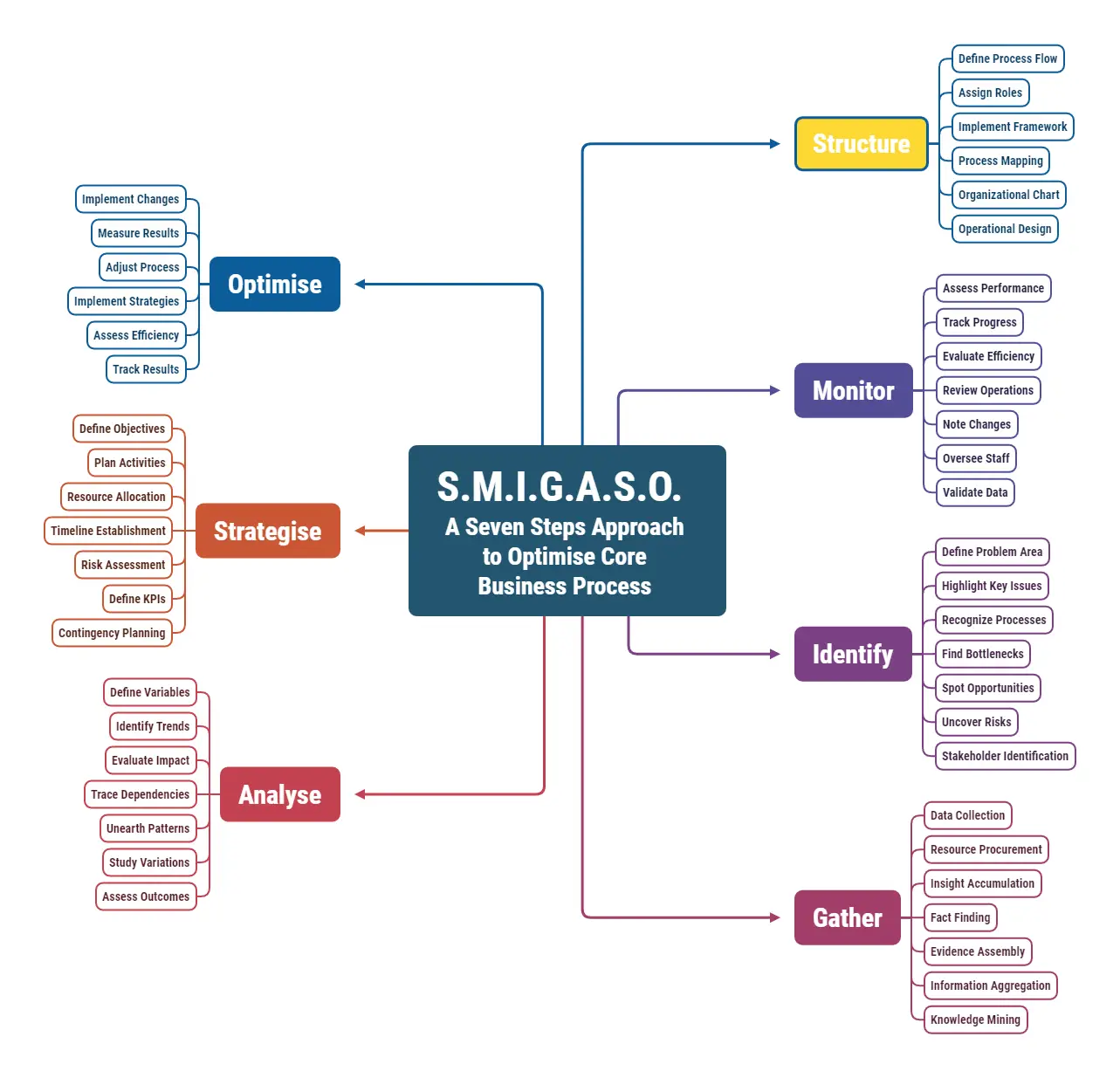S.M.I.G.A.S.O.: The Seven-Step Approach to Business Process Optimisation
A Quick Intro About What We Will Cover Here: In today’s cutthroat business world, standing still is the new moving backward. Technological advancements and globalization have amplified the need for constant adaptation and agility, so standing still is tantamount to moving backward. Businesses that fail to embrace innovation and adapt to changing market dynamics risk becoming obsolete and marginalised.
In a world where customers have access to a vast array of options and information at their fingertips, complacency can spell disaster. Companies that rest on their laurels and fail to evolve their products, services, and business models will quickly lose ground to nimble and forward-thinking competitors. The pace of change has accelerated dramatically, and businesses must be prepared to pivot and adapt on a dime to stay relevant and competitive.
Moreover, the rise of disruptive technologies and new business models has created a landscape where innovative startups and challengers can rapidly dethrone incumbents. These new players often have the agility and flexibility to experiment, iterate, and bring innovative products and services to market at a pace that traditional businesses struggle to match.
To thrive in this dynamic environment, businesses must cultivate a culture of continuous improvement, innovation, and adaptability. This means encouraging employees to think outside the box, question the status quo, and embrace new ideas. It also means investing in research and development, staying abreast of industry trends, and being willing to take calculated risks.

Create an environment where your employees are excited to come to work each day. They’ll be motivated to experiment, innovate, and come up with new ideas that will help your business grow. When your employees are happy and productive, your customers will be happy and loyal, too.
Embrace change and enable a culture of innovation. Forward-thinking positions the business to stay ahead of the curve, anticipate customer needs, and capitalise on emerging opportunities.
“I skate to where the puck is going to be, not where it has been.” – Wayne Gretzky.
Standing still is no longer an option. In today’s cutthroat business world, only those who are willing to adapt and evolve will survive and prosper. In the tumultuous waters of the business world, stagnation is a death sentence. To thrive, you must become a beacon of innovation, a pioneer who embraces change with open arms. Foster a culture where creativity is celebrated and new ideas are welcomed with enthusiasm. Seize opportunities that others can’t even fathom.
“It’s not just about surviving, though. It’s about thriving, and you can get there in a structured and well-organized way. There are no shortcuts.”
Think of it this way: your business is a living, breathing organism, and like any living thing, it needs to adapt to its environment in order to survive. The market is a constantly shifting landscape, with new technologies, customer preferences, and economic factors emerging all the time. If you stand still, you’ll quickly be left behind. Without the structure, you are guessing and that is not a solid strategy.
So, if you’re serious about transforming your business, if you’re ready to take it to the next level, then you need to make innovation a top priority.
That’s where S.M.I.G.A.S.O. comes in – your new secret weapon in the battle for market dominance. This report outlines a structured approach to business optimization that will have your competitors wondering if you’ve hired a team of business ninjas (not ninja turtles, those real ones instead).
Structure: Building the Foundation
As the great business philosopher Anonymous once said, “A goal without a plan is just a wish.” And let’s face it, wishing doesn’t pay the bills. That’s why we start with structure or at least our best attempt to create a structure (kinda “guesstimate”).
S – STRUCTURE
Think Structure is the foundation of your business process optimisation skyscraper. Without structure, we’d just have a pile of corporate rubble, and let’s face it, that’s not a great look for the company brochure.
Structured Approach: This is where we lay out the blueprint for our entire optimization process. Think of it as the business equivalent of those IKEA instructions, but hopefully with fewer leftover screws at the end (hopefully employees will read it first before they use force or fill in every hole with the screws available…)

So, this is what I recommend and why:
- First, Define Clear, Measurable Objectives: What are we trying to achieve? World domination? A 5% increase in quarterly profits? Ability to finally fix an office printer? What is it? What is in it for you? Who benefits? You need to know why you do what you do and the ultimate benefit that the process creates.
- Then, Establish a Robust Framework: Create a roadmap that even the most directionally challenged employee can follow (and if they get lost in a process to provide a clear map so that they can safely return to the base). This is your starting point so be specific, detailed and supportive. Explain, explain, explain. Enable implementation. Do what is on you. This includes process framework, documentation, results you are hoping for and the necessary steps that need to be followed.
- Quantify and allocate resources. The worst thing you can do is create a process without allocating sufficient resources for implementation. Who needs that thing when no one can get to it (this is quite reasonable)?
- Set Realistic Timelines: Because “sometime before the heat death of the universe” isn’t a great project deadline. Avoid uncertainty, avoid ambiguity. Avoid not being time driven. Please note ASAP, TBA, from next week, etc is not the timeline. It is not specific.
- Document As Is Status simply because you need to start with what you have and where you are. This is essential. Start where you are.
Remember, “What you measure, you can improve.” So, let’s make sure we’re measuring the right things, shall we?
Monitor: Keeping Your Eyes on the Prize
Now that we’ve built our foundation, it’s time to play Big Brother (the helpful kind, not the creepy one). No, this doesn’t mean installing security cameras to catch whoever keeps stealing lunches from the office fridge (though that might not be a bad idea). Staring at your employees from behind a potted plant doesn’t count. We’re talking about systematic observation and data collection.
Set up key performance indicators (KPIs) that actually mean something. Monitoring is all about keeping your finger on the pulse of your business. If you don’t feel it and understand it, my best guess is that your employees won’t know what matters and why; either.
“In God We Trust, Everyone Else Brings Data.” – W. Edwards Deming
And boy, are we going to bring data! We’ll be tracking everything from employee productivity to the number of paper clips used per quarter. (Okay, maybe not the paper clips, unless you’re really into that sort of thing.) And yes, a cardinal sin would be to slip to the mighty micromanagement S..T.
Don’t confuse measuring what matters with measuring for the sake of measuring.
Pay attention to these:
- Assess Performance: Are we meeting our KPIs, or are they meeting us in a dark alley to rough us up? You need to know if you are winning with a new process or not.
- Track Progress: Is that light at the end of the tunnel getting closer, or is it just the train of impending deadlines? Or a motorbike?
- Validate Data: Because “gut feelings” and “vibes” don’t look great on the annual report. The beauty with data is that it is neutral and objective (if you measure what matters willingly to accept results as they really are).
Identify: Playing Detective in Your Own Business Story
Once you’ve gathered enough data to make a statistician blush, it’s time to identify the problem areas—you know, those little hiccups in your operation that make you want to pull your hair out. Maybe it’s the fact that your inventory system is so outdated that it still runs on a Commodore 64 or Spectrum. Or perhaps your customer service team’s idea of “rapid response” is “we’ll get back to you in this lifetime… probably.”
Put on your deerstalker cap because it’s time to channel your inner Sherlock Holmes. We’ll identify every nook and cranny where your business could use a little TLC (“tender loving care”).
Areas to focus on:
- Problem areas (besides the dishwasher and the office fridge on a Friday afternoon and Monday morning)
- Hidden opportunities (no, not that $20 bill in your old jacket or a lottery quick wins, etc)
- Potential risks (like letting 007 James handle the client presentation without the working knowledge of PowerPoint and after his third espresso)
Gather: The Great Data Harvest
Now that you’ve identified the problems, it’s time to gather all the relevant information. Time to roll up your sleeves and get your hands dirty in the fertile soil of business data. We’re going to gather every scrap of information like it’s the last piece of cake at an office birthday party.
This means digging deep into those dusty filing cabinets, interrogating your employees (gently, of course), and maybe even asking your customers what they think. I know, I know, actually talking to customers – another revolutionary concept! Free for you because you read this post.
Remember, in the world of business optimization, data is your new best friend. It doesn’t gossip, it doesn’t take long lunch breaks, and it certainly doesn’t steal your yoghurt from the office fridge. (Looking at you, Karen from HR.)

Now we’re going on a data scavenger hunt. Leave no stone unturned, no spreadsheet unchecked, no water cooler conversation unheard.
Instead, think about:
- Data Collection: Time to harvest all those numbers you’ve been religiously inputting into various systems over the years (of course if you kept these somewhere on a reliable hard disc or perhaps the backup exist with the same reliable James 007)
- Resource Procurement: What do we need to make this happen? Budget? Staff? A small miracle? Everything mentioned?
- Insight Accumulation: Gather wisdom like you’re preparing for a business-themed episode of “Who Wants to Be a Millionaire?”
Analyse: Making Sense of the Madness
Now comes the fun part – turning all that raw data into actionable insights. It’s like alchemy, but instead of turning lead into gold, we’re turning spreadsheets into profit.
Time to put on your thinking cap, or in this case, your analysing monocle. Look at all the data you’ve gathered and try to make sense of it. Is there a pattern to the madness? Are your employees secretly plotting to replace all the office chairs with exercise balls or refurbish a kitchen area with a table tennis desk? More importantly, what’s causing the inefficiencies in your processes?
“In the swirling chaos of business data, the true entrepreneur doesn’t just see numbers – they see the dance. Learn the steps, find the rhythm, and soon you’ll be choreographing success.”
Key steps:
- Identify trends (hopefully upward ones)
- Evaluate impact (on your business, not on your stress levels)
- Unearth patterns (besides the one on your lucky tie)
- Strategise: Plotting World Domination (Or at Least Market Leadership)
Strategise: Where the Rubber Meets the Road
Now comes the tricky part where everything should come together. A very meaningful consideration coming up with a plan that doesn’t involve running away to start a new life as a cannabis grower in California (like Iron Mike). Based on your analysis, develop strategies to address the issues you’ve identified. Maybe it’s time to upgrade that prehistoric inventory system, or perhaps you need to implement a training program that doesn’t involve interpretive dance (unless you’re running a dance studio, in which case, carry on) or a simple sharp left with your Product and Services development would do the thing.
“See The Dance Ahead” – Prepare, position, leverage and dominate.”
Remember, you are armed with real data, insights from “deep blue” analysis and the unshakeable commitment to make things better. You have what it takes and what is necessary.

Armed with our newfound insights, it’s time to chart a course for success. We’re going to strategise so hard that Sun Tzu will wish he’d thought of it first.
Elements to consider:
- Define Relevant KPIs (that actually mean something)
- Plan activities or CSF – critical success factors (besides the company picnic)
- Assess risks (like the risk of becoming too awesome)
- Chart the game plan you would like your team to play.
- Redefine the game and the playing field to give yourself an unfair advantage (I personally like to play a game when I know I can’t lose)
Optimise: Where the Magic Happens
This is it—the grand finale, the big shebang, the… Well, you get the idea. It’s time to turn all our hard work into tangible results.
Steps to optimisation nirvana:
- Implement changes (and pray nothing breaks). Sometimes, despite your good intentions, things don’t work out as we expect. Don’t get discouraged.
- Measure results (obsessively). Remember, what gets measured can be managed (and eventually improved).
- Adjust and refine (rinse and repeat until perfect… or until the coffee runs out). I am lying to you now. Perfection doesn’t exist. The Process Never Stops. Now I am honest with You.
My Final Words on SMIGASO
There you have it, my entrepreneurial friend – the S.M.I.G.A.S.O. approach to business process optimization. With this structured method in your arsenal, you’ll be optimising your way to the top faster than you can say “increased quarterly earnings.”
Remember, Rome wasn’t built in a day, and your optimised business won’t be either. But with patience, persistence, and possibly a few late nights at the office, you’ll get there. And when you do, don’t forget this little wisdom.
Go forth and dive into the never-ending chase for “OPTIMAL.” Strategise, revamp, re-energise, remodel, optimise…whatever works for you. Your business empire awaits. Just don’t forget to occasionally come up for air—and maybe grab a coffee. After all, even the most optimised business runs on caffeine ( I think so).

